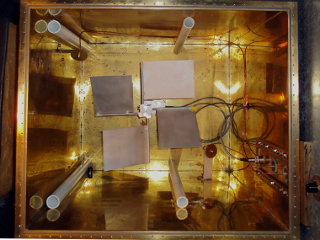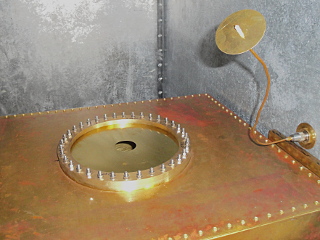Paper on absorption cross-section and antenna efficiency measurement using dual reverberation chambers
Paper on using dual reverberation chambers to measure absorption cross-section and antenna efficiency accepted for publication in IEEE Transaction on Electromagnetic Compatibility.
The standard technique for measuring absorption cross-section (ACS) in a reverberation chamber determines a value that includes the product of the radiation efficiencies of the two antennas used in the measurement (Carlberg2004). In this paper we present the theory of an alternative measurement methodology using two nested or contiguous reverberation chambers which is free from these errors caused by the radiation efficiencies of the antennas. The new method is based on the theoretical average transmission cross sections (TCSs) of circular holes in a metal plate between the two chambers. Since the existing method of measuring ACS includes the effects of the radiation efficiencies of the antennas, a comparison of the ACS of a reference object, measured using both the existing and new methods, also provides an alternative method of determining radiation antenna efficiency.


The work in the paper was the result of a collaboration between the AEG and Angelo Gifuni from Università di Napoli Parthenope. Full details of the work can be found in the paper (Gifuni et al., 2016).
References
- Gifuni, A., Flintoft, I.D., Bale, S.J., Melia, G.C.R. and Marvin, A.C., 2016. A theory of alternative methods for measurements of absorption cross section and antenna radiation efficiency using nested and contiguous reverberation chambers. IEEE Transactions on Electromagnetic Compatibility, 58(3), pp.678–685.
Average ACS can be measured in a reverberation chamber; however, the existing technique determines a value that includes the effects of the radiation efficiencies of the antennas used in the measurement. Correcting for these necessitates further complex measurements. Here, we present the theory of an alternative measurement methodology using two nested or contiguous reverberation chambers which is free from errors caused by the radiation efficiencies of the antennas. The new method is based on the theoretical average transmission cross sections (TCS) of circular holes in a metal plate between the two chambers. In fact, the method can be viewed as an accurate transfer calibration measurement between TCS and ACS that is independent of both the chamber and antenna characteristics. Further, since the existing method of measuring ACS includes the effects of the radiation efficiencies of the antennas, a comparison of the ACS of a reference object, measured using both the existing and new methods, also provides an alternative method of determining radiation antenna efficiency. Measurement uncertainties for both alternative measurement methods-ACS and antenna radiation efficiency-are also derived.
@article{Gifuni2016, author = {Gifuni, A. and Flintoft, I. D. and Bale, S. J. and Melia, G. C. R. and Marvin, A. C.}, title = {A theory of alternative methods for measurements of absorption cross section and antenna radiation efficiency using nested and contiguous reverberation chambers}, journal = {IEEE Transactions on Electromagnetic Compatibility}, year = {2016}, volume = {58}, number = {3}, pages = {678-685}, month = jun, issn = {0018-9375}, note = {Date of acceptance: 28/03/2016. © 2016 IEEE. Personal use of this material is permitted. Permission from IEEE must be obtained for all other uses, in any current or future media, including reprinting/republishing this material for advertising or promotional purposes, creating new collective works, for resale or redistribution to servers or lists, or reuse of any copyrighted component of this work in other works.}, doi = {10.1109/TEMC.2016.2548939}, file = {:pdfs/TEMC58-Gifuni-678.pdf:PDF}, keywords = {reverberation chambers, absorption cross sections, antenna radiation efficiency}, postprint = {https://pure.york.ac.uk/portal/files/48025878/TEMC_456_2015_postprint.pdf}, publisher = {IEEE} }
